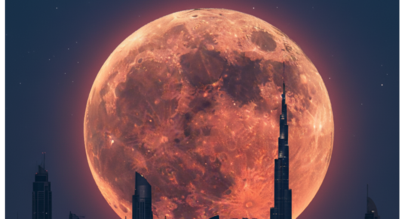The last three months of 2025 promise a rich sky show over the UAE: a run of three supermoons in October, November and December will be joined by major meteor showers – the Orionids, Leonids and Geminids giving skywatchers many clear nights to look up. Below is a compact, practical guide: exact dates, the best UAE spots to watch from, and simple photography and viewing tips so you don’t miss the action.
When to watch: Supermoon and meteor-shower dates for the UAE
At-a-glance calendar (local dates):
- Hunter’s Supermoon — October 7, 2025. A bright full moon that will dominate the night sky.
- Orionids meteor shower — peaks October 21–22, 2025. Best seen after midnight; this shower produces fast, bright meteors from Halley’s Comet debris.
- Beaver / Southern Taurids period & Supermoon — early November (Southern Taurids peak Nov 4–5) and Beaver Supermoon — November 5, 2025. Taurids are slower and produce occasional bright fireballs; the supermoon on Nov 5 will make faint meteors harder to see.
- Leonids meteor shower — peaks November 17–18, 2025. Known for quick, bright streaks; best pre-dawn viewing.
- Cold Supermoon — December 4, 2025. The last of the three consecutive supermoons.
- Geminids meteor shower — peaks December 13–14, 2025. One of the year’s strongest showers (under perfect dark-sky conditions it can produce very high hourly rates and vivid colored trails).
(Notes: the term “supermoon” describes a full moon near its closest orbital approach; meteor-shower peaks are typically given as the nights when the highest activity is expected.
Where to watch: Best UAE stargazing spots and local viewing tips
For clear, memorable views head away from city lights. Popular UAE choices include the Al Qudra Desert, the Liwa dunes, the Hajar foothills and high vantage points such as Jebel Jais locations that give darker horizons and broader sky views than the city. Plan to arrive before dusk, scout a flat, safe spot, and bring warm layers for desert or mountain nights. Local guides and astronomy clubs often organize group viewings around major events, which is a good option if you prefer structured outings. Practical tip: supermoons are bright; they wash out faint meteors, so schedule meteor-watching for nights near new moons when possible (for example, the Orionids’ peak in late October benefits from darker skies). When a supermoon and a meteor peak coincide, expect fewer visible meteors.
How to watch and photograph: simple viewing and camera tips that work
You don’t need equipment to enjoy the show, lie back, let your eyes dark-adapt for about 20–30 minutes, and scan the whole sky (meteors can appear anywhere). If you want to photograph meteors, use a tripod, shoot in manual mode with a wide-angle lens, open aperture (ideally f/2.8 or the widest your lens allows), a shutter of 10–30 seconds (use the 500/600 rule to avoid star trails) and an ISO in the 1600–3200 range; shoot many consecutive exposures rather than relying on a single long frame. These settings are a good starting point tweak for your camera and conditions. Bring a red torch to preserve night vision and shoot RAW for easier post-processing.If the moon is bright (supermoon nights), plan photography around the moonset or move focus to lunar photography. The large moon disk itself makes excellent landscape portraits when framed with dunes or mountain silhouettes.
Why it matters: a chance for science, community and striking photos
These back-to-back events are not just pretty nights; they are chances to connect with amateur astronomers, gather simple citizen-science observations (report fireballs to regional networks), and capture rare photos. The Geminids in mid-December are a highlight for photographers and families alike; the Orionids and Leonids offer quick, bright streaks that reward patience. In the UAE, where organized skywatching is growing, these events help build a community of observers and bring public attention to light-pollution and dark-sky conservation
Quick wrap — what to pack and final checklist
Bring water, blankets or reclining chairs, a warm jacket, a red flashlight, a camera on a tripod (if shooting), and patience. Check local weather and moonrise/moonset times the day before, and follow astronomy-club updates for guided viewings. Clear sky nights in October–December 2025 will reward anyone who makes the short trip out of town. Go to Source




)